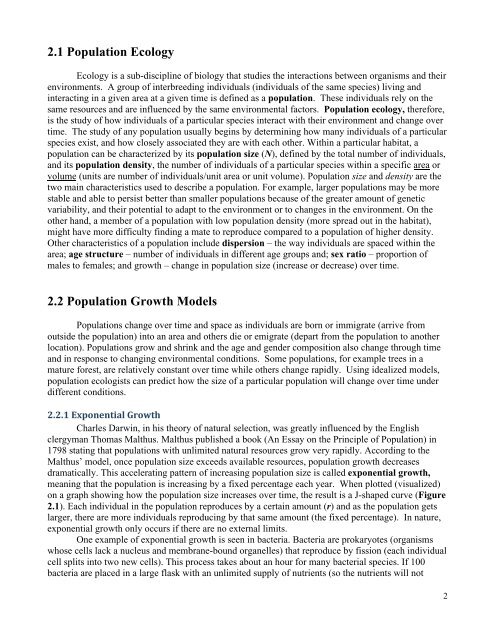Introduction to Environmental Science, 2nd Edition, 2018a
Introduction to Environmental Science, 2nd Edition, 2018a
Introduction to Environmental Science, 2nd Edition, 2018a
Create successful ePaper yourself
Turn your PDF publications into a flip-book with our unique Google optimized e-Paper software.
2.1 Population Ecology<br />
Ecology is a sub-discipline of biology that studies the interactions between organisms and their<br />
environments. A group of interbreeding individuals (individuals of the same species) living and<br />
interacting in a given area at a given time is defined as a population. These individuals rely on the<br />
same resources and are influenced by the same environmental fac<strong>to</strong>rs. Population ecology, therefore,<br />
is the study of how individuals of a particular species interact with their environment and change over<br />
time. The study of any population usually begins by determining how many individuals of a particular<br />
species exist, and how closely associated they are with each other. Within a particular habitat, a<br />
population can be characterized by its population size (N), defined by the <strong>to</strong>tal number of individuals,<br />
and its population density, the number of individuals of a particular species within a specific area or<br />
volume (units are number of individuals/unit area or unit volume). Population size and density are the<br />
two main characteristics used <strong>to</strong> describe a population. For example, larger populations may be more<br />
stable and able <strong>to</strong> persist better than smaller populations because of the greater amount of genetic<br />
variability, and their potential <strong>to</strong> adapt <strong>to</strong> the environment or <strong>to</strong> changes in the environment. On the<br />
other hand, a member of a population with low population density (more spread out in the habitat),<br />
might have more difficulty finding a mate <strong>to</strong> reproduce compared <strong>to</strong> a population of higher density.<br />
Other characteristics of a population include dispersion – the way individuals are spaced within the<br />
area; age structure – number of individuals in different age groups and; sex ratio – proportion of<br />
males <strong>to</strong> females; and growth – change in population size (increase or decrease) over time.<br />
2.2 Population Growth Models<br />
Populations change over time and space as individuals are born or immigrate (arrive from<br />
outside the population) in<strong>to</strong> an area and others die or emigrate (depart from the population <strong>to</strong> another<br />
location). Populations grow and shrink and the age and gender composition also change through time<br />
and in response <strong>to</strong> changing environmental conditions. Some populations, for example trees in a<br />
mature forest, are relatively constant over time while others change rapidly. Using idealized models,<br />
population ecologists can predict how the size of a particular population will change over time under<br />
different conditions.<br />
<br />
Charles Darwin, in his theory of natural selection, was greatly influenced by the English<br />
clergyman Thomas Malthus. Malthus published a book (An Essay on the Principle of Population) in<br />
1798 stating that populations with unlimited natural resources grow very rapidly. According <strong>to</strong> the<br />
Malthus’ model, once population size exceeds available resources, population growth decreases<br />
dramatically. This accelerating pattern of increasing population size is called exponential growth,<br />
meaning that the population is increasing by a fixed percentage each year. When plotted (visualized)<br />
on a graph showing how the population size increases over time, the result is a J-shaped curve (Figure<br />
2.1). Each individual in the population reproduces by a certain amount (r) and as the population gets<br />
larger, there are more individuals reproducing by that same amount (the fixed percentage). In nature,<br />
exponential growth only occurs if there are no external limits.<br />
One example of exponential growth is seen in bacteria. Bacteria are prokaryotes (organisms<br />
whose cells lack a nucleus and membrane-bound organelles) that reproduce by fission (each individual<br />
cell splits in<strong>to</strong> two new cells). This process takes about an hour for many bacterial species. If 100<br />
bacteria are placed in a large flask with an unlimited supply of nutrients (so the nutrients will not<br />
2


















